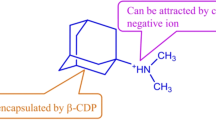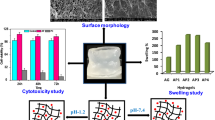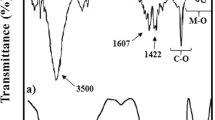Abstract
We report the synthesis of semi-interpenetrating polymer network (semi-IPN) hydrogel composed of carboxymethyl cellulose (CMC), linear polyvinylpyrrolidone (PVP), acrylic acid (AA) and α-cyclodextrin (CD) by free-radical solution polymerization in presence of hydrogen peroxide as the initiator and its characterization by FTIR, SEM and Rheology. The formulated hydrogel is thermoreversible, and its rheological parameters like gelation temperature, gelation time, elastic modulus and stress were studied as a function of CD concentrations. Swelling ability of the hydrogel decreases while as the drug encapsulation and loading capacities enhance with increase in CD wt%. The partitioning of ibuprofen between regions of different polarity within the hydrogel was studied by spectrofluorimetry. The ability of hydrogel with 0.04 wt% of CD to release ibuprofen spanned over the time period of 2 h and was modelled in light of various kinetic models.









Similar content being viewed by others
References
Hatice KC (2005) Synthesis of persulfate containing poly (N-vinyl-2-pyrrolidone) (PVP) hydrogels in aqueous solutions by g-induced radiation. Radiat Phys Chem 72:703–710
Krishna Rao KSV, Naidu BVK, Subha MCS, Sairam M, Aminabhavi TM (2006) Novel chitosan-based pH-sensitive interpenetrating network microgels for the controlled release of cefadroxil. Carbohydr Polym 66:333–344
Myung D, Waters D, Wiseman M, Duhamel PE, Noolandi J, Ta CN (2008) Progress in the development of interpenetrating polymer network hydrogels. Polym Adv Technol 19:647–657
Kiatkamjornwong S, Mongkolsawat K, Sonsuk M (2002) Synthesis and property characterization of cassava starch grafted poly [acrylamide-co- (maleic acid)] superabsorbent via γ-irradiation. Polymer 43:3915–3924
Opdahl A, KimSH KTS, Marmo C, Somorjai GA (2003) Surface mechanical properties of pHEMA contact lenses: viscoelastic and adhesive property changes on exposure to controlled humidity. J Biomed Mater Res A 67:350–356
Yang X, Zhu Z, Liu Q, Chen X, Ma M (2008) Effects of PVA, agar contents, and irradiation doses on properties of PVA/ws-chitosan/glycerol hydrogels made by γ-irradiation followed by freeze-thawing. Radiat Phys Chem 77:954–960
Qiu Y, Park K (2001) Environment-sensitive hydrogels for drug delivery. Adv Drug Deliv Rev 53(3):321–339
Lee KY, Mooney DJ (2001) Hydrogels for tissue engineering. Chem Rev 101(7):1869–1879
Jones A, Vaughan D (2005) Hydrogel dressings in the management of a variety of wound types: a review. J Orthop Nurs 9(Supplement 1):S1–S11
Bharali JD, Shaoo SK, Mozumdar S, Maitra A (2003) Cross-linked polyvinylpyrrolidone nanoparticles: a potential carrier for hydrophilic drugs. J Colloid Interface Sci 258:415–423
Vasir JK, Tambwekar K, Garg S (2003) Bioadhesive microspheres as a controlled drug delivery system. Int J Pharm 255:13–32
Chirila TV, Rakoczy PE, Garrett KL, Lou XCostanble IJ (2002) The use of synthetic polymers for delivery of therapeutic antisense oligodeoxynucleotides. Biomaterials 23:321–342
Gulyuz U, Okay O (2013) Self-healing polyacrylic acid hydrogels. Soft Matter 9:10287
Nguyena MK, Alsberg E (2014) Bioactive factor delivery strategies from engineered polymer hydrogels for therapeutic medicine. Prog Polym Sci 39:1235–1265
Sahiner N (2013) Soft and flexible hydrogel templates of different sizes andvarious functionalities for metal nanoparticle preparationand their use in catalysis. Prog Polym Sci 38:1329–1356
Wang W, WangQ WA (2011) pH-Responsive Carboxymethylcellulose-g Poly(sodium acrylate)/Polyvinylpyrrolidone Semi-IPN Hydrogels with Enhanced Responsive and Swelling Properties. Macromol Res 19:57–65
Peng X-W, Ren J-L, Lin-XinZhong FP, Sun R-C (2011) Xylan-rich Hemicelluloses-graft-Acrylic Acid Ionic Hydrogels with Rapid Responses to pH, Salt, and Organic Solvents. J Agric Food Chem 59:8208–8215
Omidian H, Park K (2012) Fundamentals and Applications of Controlled Release Drug Delivery. Adv Deliv Sci Technol 75:105
Guo JH, Skinner GW, Harcum WW, Barnum PE (1998) Pharmaceutical applications of naturally occurring water-soluble polymers. Pharm Sci Technol Today 1:254
Omidian H, et al (2005) Hydrogels having enhanced elasticity and mechanical strengthproperties in US patent, 6,960,617
Omidian H, Rocca JG (2006) Formation of strong superporous hydrogels in US patent, 7, 056,957
Omidian H, Rocca JG, Park K (2006) Elastic, superporous hydrogel hybrids of polyacrylamide and sodium alginate. Macromol Biosci 6:703–710
Dhar N, Akhlaghi SP, Tam KC (2012) Biodegradable and biocompatible polyampholyte microgels derived from chitosan, carboxymethyl cellulose and modified methyl cellulose. Carbohydr Polym 87:101–109
Manakker F, Vermonden T, Nostrum CF, Hennink WE (2009) Cyclodextrin-based polymeric materials: synthesis, properties, and pharmaceutical /biomedical applications. Biomacromolecules 10:3157
Jiang GB, Quan D, Liao K, Wang H (2006) Novel Polymer Micelles Prepared from Chitosan Grafted Hydrophobic Palmitoyl Groups for Drug Delivery. Mol Pharm 3:152–160
Liu TY, Lin YL (2010) Novel pH-sensitive chitosan-based hydrogel for encapsulating poorly water-soluble drugs. Acta Biomater 6:1423–1429
Wang J, Somasundaran P (2005) Adsorption and conformation of carboxymethyl cellulose at solid–liquid interfaces using spectroscopic, AFM and allied techniques. J Colloid Interface Sci 291:75–83
Gajare P, Patil C, Kalyane N, Pore Y (2009) Effect 0f Hydrophilic Polymers on Pioglitazone Complexation with Hydroxypropyl-β-Cyclodextrin. Dig J Nanomater Biostruct 4:891–897
Kulbida A, Ramos MN, Rasanen M, Nieminen J, Schrems O, Fausto R (1995) Rotational Isomerism in Acrylic Acid- A Combined Matrix-isolated IR, Raman and ab initio Molecular Orbital Study. J Chem Soc Faraday Trans 91:1571–1585
Oxley J, Smith J, Brady J, Dubnikova F, Kosloff R, Zeiri L, Zeiri Y (2008) Raman and Infrared Fingerprint Spectroscopy of Peroxide-Based Explosives. Appl Spectrosc 62:906
McMurry J (2007) Organic chemistry with biological approach. Cengage Learning. Inc. ISBN-13: 978-0-495-39144-9
Aouada FA, de Moura MR, Rubira AF, Muniz EC, Fernandes PRG, Mukai H, da Silveira ACF, Itri R (2006) Birefringent hydrogels based on PAAm and lyotropic liquid crystal: optical, morphological and hydrophilic characterization. Eur Polym J42:2781–2790
Yang X, Liu Q, Chen X, Yu F, Zhu Z (2008) Investigation of PVA/ws-chitosan hydrogels prepared by combined c-irradiation and freeze-thawing. Carbohydr Polym 73:401–408
Moura MJ, Figueiredo MM, Gil MH (2007) Rheological Study of Genipin Cross-Linked Chitosan Hydrogels. Biomacromolecules 8:3823–3829
Hou Q, De Bank PA, Shakesheff KM (2004) Injectable scaffolds for tissue regeneration. J Mater Chem 14:1915–1923
Hafeti A, Amsden B (2002) Biodegradable injectable in situ forming drug delivery systems. J Control Release 80:9–28
Fechine GJM, Barros JAG, Alcantara MR, Catalani LH (2006) Fluorescence polarization and rheological studies of the poly (N-vinyl-2-pyrrolidone) hydrogels produced by UV radiation. Polymer 47:2629–2633
Sharma SC, Shrestha LK, Tsuchiya K, Sakai K, Sakai H, Abe M (2009) Viscoelastic Wormlike Micelles of Long Polyoxyethylene Chain Phytosterol with Lipophilic Nonionic Surfactant in Aqueous Solution. J Phys Chem B 113:3043–3050
BirdRB ARC, Hassager O (1987) Dynamics of polymeric liquids—volume 1: fluid mechanics, 2nd edn. John Wiley, New York
Rubinstein M, Colby RH (2003) Polymer Physics(Oxford University Press)
Anseth KS, Bowman CN, Brannon-Peppas L (1996) Mechanical properties of hydrogels and their experimental determination. Biomaterials 17:1647–1657
Kavanagh GM, Ross-Murphy Simon B (1998) Rheological characterisation of polymer gels. Prog Polym Sci 23:533–562
Ghosh K, Shu XZ, Mou R, Lombardi J, Prestwich GD, Rafailovich MH, Clark RAF (2005) Rheological Characterization of in Situ Cross-Linkable Hyaluronan Hydrogels. Biomacromolecules 6:2857–2865
Kono H (2014) Characterization and properties of carboxymethylcellulose hydrogels crosslinked by polyethyleneglycol. Carbohydr Polym 106:84–93
Nho YC, Park JS, Lim YM (2014) Preparation of Poly(acrylic acid) Hydrogel by Radiation Crosslinking and Its Application for Mucoadhesives. Polymers 6:890–898
Costa P, Lobo JMS (2001) Modeling and comparison of dissolution profiles. Eur J Pharm Sci 13:123–133
Higuchi T (1963) Mechanism of sustained-action medication. Theoretical analysis of rate of release of solid drugs dispersed in solid matrices. J Pharm Sci 52:1145–1149
Cowley JD, Pasha I (1981) The fluorescence of some dipolar NN-dialkyl-4-(dichloro-1,3,5-triazinyl)anilines. Part 2. Temperature and solvent effects on the radiationless decay of an intramolecular charge-transfer excited singlet state. J Chem Soc Perkin Trans 2:918
Cowley JD, Okame E, Todd RST (1991) Triazinylaniline derivatives as fluorescence probes. Part 1. Absorption and fluorescence in organic solvents and in aqueous media in relation to twisted intramolecular charge-transfer state formation, hydrogen bonding, and protic equilibria. J Chem Soc Perkin Trans 2:1495
El-Daly SA, Abdel-Kader MH, Issa RM, El-Sherbini EA (2003) Influence of solvent polarity and medium acidity on the UV_/Vis spectral behavior of 1-methyl-4-[4-amino-styryl] pyridinum iodide. Spectrochim Acta A 59:405–411
Acknowledgments
AAD acknowledges the Department of Science and Technology (DST), Govt. of India, for providing funds under the FIST scheme to the Department of Chemistry, University of Kashmir, for procuring various instruments.
Author information
Authors and Affiliations
Corresponding author
Rights and permissions
About this article
Cite this article
Maswal, M., Chat, O.A. & Dar, A.A. Rheological characterization of multi-component hydrogel based on carboxymethyl cellulose: insight into its encapsulation capacity and release kinetics towards ibuprofen. Colloid Polym Sci 293, 1723–1735 (2015). https://doi.org/10.1007/s00396-015-3545-4
Received:
Revised:
Accepted:
Published:
Issue Date:
DOI: https://doi.org/10.1007/s00396-015-3545-4




